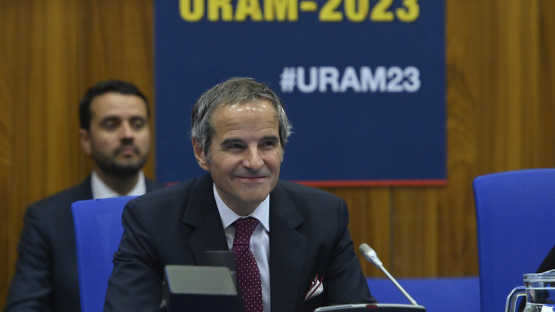With interest in nuclear power growing worldwide, demand for uranium—the element from which fuel for nuclear reactors is fabricated—is also on the rise. International experts and stakeholders gathered at the IAEA this week to analyze the latest developments in the uranium production cycle, including supply-demand scenarios, to ensure the long-term sustainability of nuclear power.
“When we look at the global situation as well as the UN Sustainable Development Goals (SDGs) and the Paris Agreement, addressing it all will largely depend on our ability to have one factor right: energy,” IAEA Director General Rafael Mariano Grossi said in remarks to the weeklong International Symposium on Uranium Raw Material for the Nuclear Cycle (URAM-2023), which concluded in Vienna today. “But to meet the expected future increase in nuclear power capacity, we will need significant innovation and qualified personnel to recover untapped uranium resources to sustainably fuel the reactor fleet of the future.”
The Symposium examined all aspects of uranium raw materials for the uranium fuel cycle, including developments and innovations in uranium geology, exploration, mining, processing, and site decommissioning. The hybrid event brought together 260 participants and 120 observers from 62 countries and three other international organizations, with some 165 people attending in person. Organized in cooperation with the World Nuclear Association, the event also featured an essay contest for students and early career professionals, with Mr Grossi presenting the four winners with certificates.
Currently, some 60,000 tonnes of uranium are required annually to fuel the world’s 410 operating nuclear power reactors, according to the 2022 Red Book, a publication on uranium resources, production and demand issued by the IAEA and the Nuclear Energy Agency of the Organisation for Economic Co-operation and Development.
However, with countries increasingly expected to turn to nuclear power to address climate change, energy security and sustainable development, demand could be as high as 100,000 tonnes of uranium per year by 2040. That would require a near doubling of uranium mining and processing from current levels. Amid this fresh focus on uranium during the global energy crisis, which has seen energy costs skyrocket, uranium spot prices have increased by some 50% over the last two years.
“The world is on the cusp of another uptick in interest in uranium as a commodity and in nuclear power as an increasingly important source of low-carbon energy,” said Susan Hall, the Symposium Chair and a geologist with the U.S. Geological Survey.
Nuclear power generating capacity could more than double by 2050, according to the IAEA’s latest projections on the future potential of the energy source. According to the International Energy Agency, nuclear power capacity must double in a secure global pathway to net zero emissions by mid-century.
The four winning essays presented in the Symposium’s opening session touched on themes related to the role of young people in driving the future of nuclear energy through innovation in the uranium sector. The winners were Mr Cebastian Guembou Shouop of Cameroon; Ms Fatou Gitteh of The Gambia; Ms Dwi Rahayu of Indonesia; Mr Daniyar Ashimov of Kazakhstan.
However, the world’s future supply of uranium will be impacted by several factors, Mrs Hall said. These included identifying in-place resources with advanced exploration techniques, technical and geopolitical vulnerabilities in permitting and operating mines, securing project development funding, and supply chain aspects.
According to the Red Book, there are more than 6 million tonnes of uranium resources in the ground, roughly equivalent to 100 years of current demand. Not all this identified uranium is expected to become nuclear fuel and a large amount is technically challenging to recover. Significant innovation and well qualified personnel will be needed in the coming years to address the challenge.
“Globally, there is a need for more uranium exploration and new mine development in the near term to meet growing demand,” said Brett Moldovan, leader of the IAEA Uranium Resources and Production team and Scientific Secretary for URAM-2023. “Looking further ahead, to ensure the long-term sustainability of nuclear energy, further innovations will be needed so that challenging low-grade uranium resources can be identified and mined in a safe, secure and environmentally sound way.”



